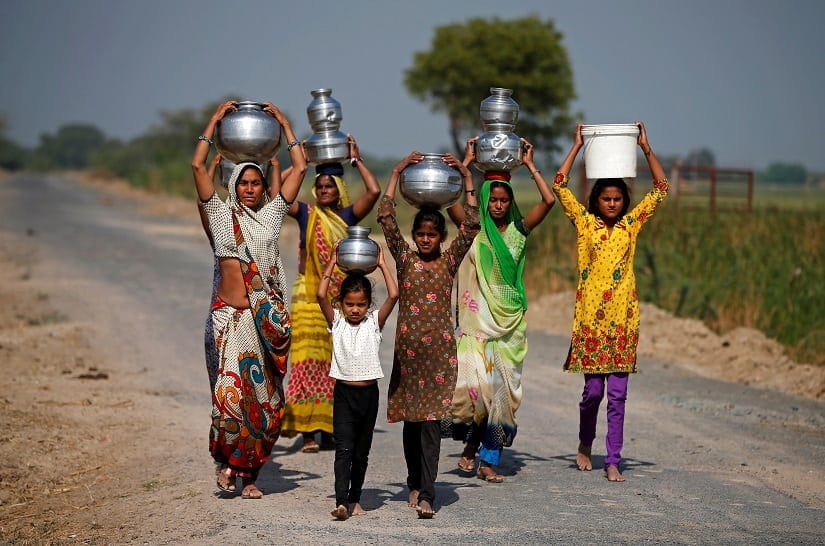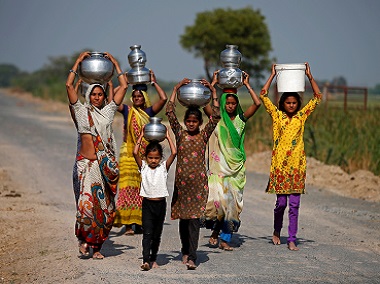For most of us, accessing water is as simple as turning the taps on in our kitchens and toilets. But for a large number of the world’s population, access to clean and safe water remains a major challenge. Even as recently as in 2015, at least 844 million people across the world — 12 percent of the global population — were still lacking basic drinking water services. These people still rely on unprotected wells, rivers and springs or take water directly from surface sources. When water is not available at home, the burden of collecting, storing, and managing it usually falls on women and girls in most families around the world. Globally, in eight out of 10 households lacking water provision, it is women and girls who bear this responsibility. [caption id=“attachment_6307331” align=“alignnone” width=“825”]  Pictures of women carrying pots may be beautiful and widespread in popular culture, but it is a crime and outrage in the 21st century that women are girls are still carrying 20 litres on their heads for kilometres every day. REUTERS[/caption] Water scarcity has serious implications on women’s health. When schools fail to provide adequate water and sanitation facilities, one of the reasons girls drop out is the difficulty in maintaining menstrual hygiene. When their homes do not provide access either, girls and women often limit their water and food intake — forced to spend entire days without relieving themselves or awaiting the privacy that darkness provides. On Firstpost: Climate change will worsen the power imbalances that hurt women — it's time to address them When they have to relieve themselves outdoors, they run the risk of contracting diseases like diarrhoea, hepatitis, and cholera which are worsened by undernutrition. Many-a-time, they may be bound by social norms to not venture out of their domestic spaces. They are also vulnerable to sexual assault when they do. We are still horrified by the incident in Katra (Uttar Pradesh) in 2014, when two girls — aged 14 and 15 years — were assaulted and found dead one evening when they ventured out to defecate in the open. Such stories show how poor access to water and sanitation not only affects the health and lives of women and girls disproportionately, but also negatively affects their wellbeing and dignity.
All over the global South, women and girls walk an average of six km each day to collect water.
In Tigray, in Ethiopia, one of us encountered 20 girls and women gathered patiently next to a water source. They had been waiting for almost three hours for someone to turn the tap on and release the supply of water for the catchment area. This is part of their everyday lives. Even in urban settings, women queuing up at taps to fill their buckets is a common sight. It is alarming that a source which can be accessed within 30 minutes (round-trip collection time) is considered an “improved water source” as per the new approach of the SDG indicators tracking progress in drinking water, sanitation, and hygiene. No doubt, poor women may need to make multiple trips like this with heavy water pots. That such a situation is considered acceptable reflects the critical need to ensure that more women are part of the decision-making processes when such standards and targets are being set.
In fact, globally, women spend up to 200 million hours every day collecting water.
The massive number of hours and the labour that these girls and women spend in simply collecting, providing, and managing water for their households/communities distorts their lives, and the labour spent is unaccounted for and unremunerated. If these millions of hours could be taken off from their hands, pathways and opportunities would open up, helping them lead more productive lives, either through time spent in education or in paid work. Much has been made of the global water ‘crises’. However, most often than not, this has little to do with the physical availability of water. Access to water is usually linked with unequal social, gender and power relations as well as to distortions in policies, planning and management structures. In India, water crises usually emerge because access to and control over water is differentiated due to caste, gender, and wealth. Thus, the water crisis is a socially mediated one, with water often flowing uphill to money and power. In December 2018, one of us was part of a panel discussion — “Does Water Have Gender?” — at a litfest in Mumbai, where the speakers deliberated on the debilitating impact that such politics have on women’s lives and livelihoods. Nearly 163 million of India’s 1.3 billion people lack access to clean water, with rural populations worst-affected by this inequity. A co-panellist pointed out that though the Government of India aims to ensure that 90 percent households receive piped water supply in the next three years, if men would have been assigned the roles of collecting and managing water, this target would have been universal. Also read: India's water future threatened by the combined effect of climate change and rising demand On an average, a woman in rural India walks 5-20 km a day just to fetch water. The Indian government’s Swachh Bharat initiative seeks to build toilets, end open defecation, and improve sanitation in the country. But we discussed that simply building infrastructure will not solve the problem. This initiative has become top-down and target driven. In many cases the money has been diverted elsewhere or toilets have not been used or are not functional, especially for women who have to bear the double burden of indignity and unsafe conditions when having to relieve themselves in the open. The media has a key role to play in ensuring that conversations and decisions on resources like water include a woman’s perspective. Global and Indian cinema, in recent times, have tackled this issue from a woman’s lens and we need more such initiatives and conversations in public forums. The lack of access to water is a violation of poor women and men’s human rights. Pictures of women carrying pots may be beautiful and widespread in popular culture, but it is a crime and outrage in the 21st century that women are girls are still carrying 20 litres on their heads for kilometres every day. Men and women from all walks of life need to be included in such conversations and, more importantly, governments and political leaders should be held to account for this situation. Professor Lyla Mehta is at the Institute of Development studies, UK. Ria Basu is manager, Global Health Strategies, India. Take our World Water Day 2019 Quiz here.


)

)
)
)
)
)
)
)
)



